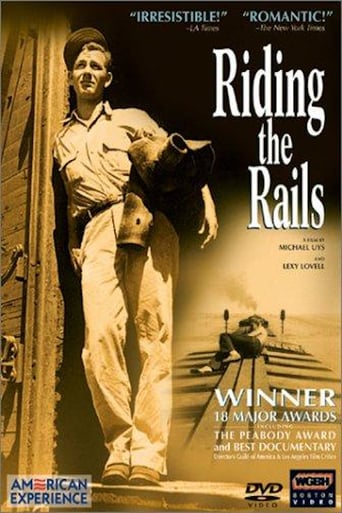

After playing with our expectations, this turns out to be a very different sort of film.
... View MoreThis is ultimately a movie about the very bad things that can happen when we don't address our unease, when we just try to brush it off, whether that's to fit in or to preserve our self-image.
... View MoreThe film may be flawed, but its message is not.
... View MoreOne of the most extraordinary films you will see this year. Take that as you want.
... View MoreRiding the Rails: American Experience, 1997.Riding the rails was a humiliating, dangerous, disappointing, unhealthy life for 4 million people during the Great Depression. Some of them eventually escaped into the Civilian Conservation Corps, that provided the income and self-respect that had eluded them in their travels. The American Experience did its homework, and presents a compelling narrative, told in large part by many of the then-teenage hoboes, 60 years later. The show is full of great music, including songs by Bob 'Guitar Whitey' Symmonds, ex-hobo and fine musician. The American Experience had put out a call for letters from people who had ridden the rails as teenagers in the Depression, and received 3,000. From these and plenty more research, they put together a fine show.
... View MoreI got my first look at the hobo life on screen in the 1933 film "Wild Boys of the Road", noted briefly here for it's warning to the era's teenagers how dangerous and depressing the wandering life could be. "Riding the Rails" mixes film clips of the Great Depression with commentary from real folks who hopped trains during the 1930's escaping from home, looking for work, or simply seeking adventure. The usual outcome however, generally found these travelers panhandling and barely making ends meet while facing untold dangers along the way. The early 1930's found millions of these wanderers criss crossing the country, but a staggering number, two hundred fifty thousand or so, were actually teenage runaways. A handful among the mix were young girls, sometimes resorting to prostitution to make their way among the hobo jungles that dotted the landscape along the great rail lines. Some of them had romantic sounding names like the Cotton Belt Route and the Nickel Plate Road, but the carefree attitude one might associate with the vagabond life often wound up in desperate circumstances of poverty and crime. What's most interesting to hear are the real stories of the people who took up the wanderlust for a brief period of their young lives, earning money by picking fruit, hitching up with traveling carnivals and circuses, or catching a lucky break to find steady work. Their tales seemed to be more wistful than happy, and often exhibited a sense of sadness that things had to be the way they were. Made in 1997, this documentary serves as a gritty wake up call for a current generation who find it hard to get by on mere hundred dollar sneakers and the indispensable cell phone.
... View MoreRiding the Rails: American Experience is narrated mostly by people who spent their depression days riding the rails looking for work. Most of the film covers teenagers because those are the only ones still alive from those times. The needs, trials, and tribulations were all the same. Where's the next meal coming from and when will things get better. California was turning people away from its borders until the New Deal brought the CCC to help the kids from getting lost in the life of the hobo. A pretty emotional film filled with the hopes and dreams of youth with little to look forward to. Some very political sides to the story as most of the people's lives were so hard they lean more toward social programs. Lets hope we never have another depression. A must watch for those not old enough to hear about the depression or those not taught it in any detail in school.
... View MoreRiding the Rails is the story of the children the either ran away or were forced to leave home during the depression. In most movies the hobos riding the rails are shown as grown men and as bums. This movie debunks that myth and shows that most of the rail riders were teenage runaways. The story is told very effectively in a series of interviews with the survivors from this era and shows footage from old movies and newsreel. Most of survivors are now in their late 70's or 80's but were as young as 13 when they first ran away. These are very personal stories about children who had no hope of a better life and how they hopped boxcars hoping to find something better.I've seen this documentary a number of times now and it never fails to move me. I remember the first time it came on TV it was late at night, I had to work the next day but I couldn't stop watching it. The whole next week I couldn't get these people out of my mind. It all happened over 60 years ago when the world was a very different place and yet their stories are still very moving today. This documentary really captures the desperateness of the depression and shows the sincerity of the people that grew up in that time. The film does have a happy ending but it may not be everyone's cup of tea. This is not a movie five star yuppies will enjoy, however if you have ever been a backpacker, a hitchhiker or a traveller you may find this is a documentary you can relate to.
... View More